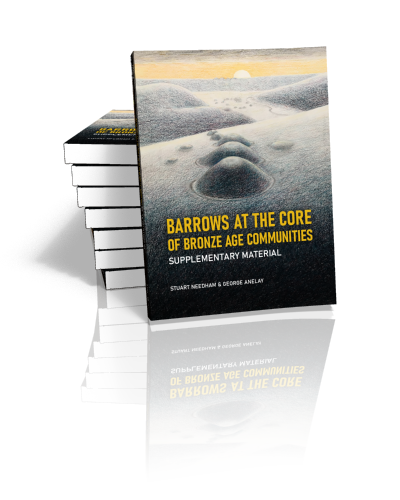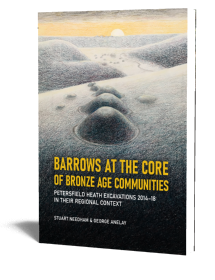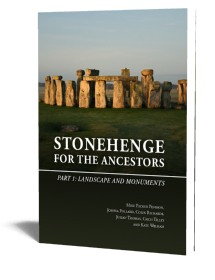Barrows at the core of Bronze Age Communities
Supplementary Material
Stuart Needham & George Anelay | 2021

Barrows at the core of Bronze Age Communities
Supplementary Material
Stuart Needham & George Anelay | 2021
Paperback ISBN: 9789464260465 | Hardback ISBN: 9789464260472 | Imprint: Sidestone Press | Format: 210x280mm | 258 pp. | Language: English | 85 illus. (bw) | 59 illus. (fc) | Keywords: Mesolithic; Neolithic; Bronze Age; barrows; burial diversity; community interpretation; demographic estimation; prehistoric field systems; heathland; micro-excavation; history of Petersfield Heath | download cover
Read online or downloaded 457 times
-
Digital & Online access
This is a full Open Access publication, click below to buy in print, browse, or download for free.
-
Buy via Sidestone (EU & UK)
-
Buy via our Distributors (WORLD)
For non-EU or UK destinations you can buy our books via our international distributors. Although prices may vary this will ensure speedy delivery and reduction in shipping costs or import tax. But you can also order with us directly via the module above.
UK international distributor
USA international distributor
-
Bookinfo
Paperback ISBN: 9789464260465 | Hardback ISBN: 9789464260472 | Imprint: Sidestone Press | Format: 210x280mm | 258 pp. | Language: English | 85 illus. (bw) | 59 illus. (fc) | Keywords: Mesolithic; Neolithic; Bronze Age; barrows; burial diversity; community interpretation; demographic estimation; prehistoric field systems; heathland; micro-excavation; history of Petersfield Heath | download cover
Read online or downloaded 457 times

We will plant a tree for each order containing a paperback or hardback book via OneTreePlanted.org.
Barrows at the Core of Bronze Age Communities argues exactly that. Round barrows do not just represent the death side of Early Bronze Age communities placed in set-a-side ritual landscapes, but were instead central to existence in many ways. This study of the Rother Region, where the Weald meets the Wessex massif, reports the results of the People of the Heath project, 2014–18. It integrates a wealth of data from comprehensive field study of all relevant sites in the region with that from excavations into one of its major cemeteries – Petersfield Heath, Hampshire. Fourteen of 21 surviving barrows were sampled by excavation, one of the fullest records for such a cemetery in modern times. In addition to diverse burial rites, the site yielded a range of ‘other significant deposits’ and totally novel insights into the organic artefact repertoire thanks to mineral replacement.
Amongst the supplementary material in this volume are: a crucial new analysis of enclosure barrows in Wessex; further analyses regarding barrow morphologies, condition, cemetery formation and siting; observations on damage and recommendations on the future management of the archaeology of Petersfield Heath; detailed context descriptions for the block-lifted urns and log-coffin burial subjected to pioneering stratigraphic micro-excavation; summaries of palaeoenvironmental evidence from the region; the full report on quartz optical dating; a major re-assessment of the excavated ring-ditch at Heath End, Duncton; further detail on finds; and details on various methodologies and definitions employed in the volume.
Together the two volumes contain much new for those researching the period, early burial practices and the prehistoric occupation of the western Weald. They will also galvanise debates about variations in the character of barrowscapes across Britain and the place of the Wessex barrow foci.
This volume contains the supplementary material for the main volume: Barrows at the core of Bronze Age Communities
In addition to the two printed volumes, an online dataset comprising spreadsheets is available at www.petersfieldmuseum.co.uk/people-heath
Nominated for Current Archaeology “Book of the Year”
If your allegiances do not lie elsewhere, please consider voting for Barrows at the Core of Bronze Age Communities for Book of the Year 2023. Voting ends 1 February ready for the announcement on 25 Feb: www.archaeology.co.uk/vote
Appendix 1.1: Detailed observations on damage to monuments and recommendations on the future management of the archaeology of Petersfield Heath
George Anelay and Stuart Needham
Appendix 1.2: Synopsis of the People of the Heath project (2014)
Stuart Needham and George Anelay
Appendix 1.3: List of consulted maps showing Petersfield Heath
Robert Banbury and George Anelay
Appendix 5.1: Calculations for the area of land stripped to make the western tump in Barrow 4
Stuart Needham
Appendix 7.1: Modern mounds and ‘enclosures’ on the Heath and the islands in the Pond
Stuart Needham
Appendix 8.1: Matrix of micro-excavated contexts at the base of the log coffin, Barrow 19, grave [406]
Carol Hartzenberg and Stuart Needham
Appendix 8.2: Special finds (SF) associated with the base of the log coffin, Barrow 19
Carol Hartzenberg
Appendix 9.1: Special finds (SF) associated with the urn burials
Jane King
Appendix 9.2: Summary table of micro-excavated contexts for Urn 1, Barrow 8
Jane King
Appendix 9.3: Summary table of micro-excavated contexts for Urn 2, Barrow 19
Jane King
Appendix 9.4 Summary table of micro-excavated contexts for Urn 3, Barrow 19
Jane King
Appendix 9.5: Summary table of micro-excavated contexts for Urn 4, Barrow 14
Jane King
Appendix 11.1: Spreadsheet for human bone identifications
Emily Carroll
Appendix 12.1: Selected drawings of Late Upper Palaeolithic (LUP) and Mesolithic flintwork
Mary Haskins
Appendix 12.2: Site 23 microlithic component
Anthony Haskins
Appendix 12.3: Gazetteer of Mesolithic sites within the study area
Robert Banbury
Appendix 13.1: Appendix 13.1 Other post-medieval to modern finds
George Anelay, Ken Mordle and Dave Bullock
Appendix 13.2: Details of unworked stone material and daub
Stuart Needham, with identifications by David Bone
Appendix 13.3: Petrographic analysis of eight stone objects
Patrick Sean Quinn
Appendix 13.4: Lipid analysis of sherds from Petersfield Heath
Julie Dunne
Appendix 13.5: Further details on mineral-replaced organics and other soil forms
Stuart Needham
Appendix 13.6: Report on the compositional analysis of the Bronze Age beads
Lore Troalen
Appendix 13.7: Virtual model of the Barrow 13 cremation-sack handle
Marta Diaz-Guardamino
Appendix 13.8: Processing, recording and conserving the mineral-replaced wooden handle, ORG13
Stuart Needham
Appendix 13.9: Further details of wood from Barrows 19 and 24
Stuart Needham
Appendix 14.1: Further aspects of the excavated soils
Stuart Needham
Appendix 15.1: Quartz optical dating report
Mark Bateman
Appendix 16.1: Register of barrows and potential barrows in the Rother Region
Stuart Needham and Sabine Stevenson
Appendix 16.2: Barrow register fields: definitions and notations
Stuart Needham and Sabine Stevenson
Appendix 16.3: Field methods and database creation for the Regional Barrow Survey
Stuart Needham
Appendix 16.4: Summary table of the landscape relationships of potential enclosure barrows
Stuart Needham
Appendix 16.5: Further aspects of barrow morphology
Stuart Needham
Appendix 16.6: Comparative analysis of enclosure barrows in Wessex
Stuart Needham
Appendix 16.7: Effects of denudation and damage on dimensions, including volume
Stuart Needham
Appendix 17.1: Barrow occurrence in relation to geology
Stuart Needham and Sabine Stevenson
Appendix 17.2: Further detail on soils in the Rother Region
Stuart Needham
Appendix 17.3: Further aspects of topographic siting
Stuart Needham
Appendix 17.4: Definition of barrow groups, subgroups, pairs and singletons
Stuart Needham and Sabine Stevenson
Appendix 17.5: Barrow-group formations and their topographic setting
Stuart Needham
Appendix 18.1: Descriptions of barrow groups, pairs and singletons by Zone
Stuart Needham and Sabine Stevenson
Appendix 18.2: Details on the mapping of land-use categories
Stuart Needham
Appendix 19.1: Bronze Age burial evidence from the Rother Region
Stuart Needham and Sabine Stevenson
Appendix 19.2: Re-assessment of the Heath End Duncton ring-ditch (9618/13)
Stuart Needham
Appendix 19.3: Evaluation of radiocarbon dates from West Heath Common
Stuart Needham
Appendix 20.1: Summaries of palaeo-environmental evidence from sites in the Rother Region
Stuart Needham
Appendix 20.2: Summary table of diagnostic Neolithic flintwork from the Rother Region
Sabine Stevenson
Appendix 20.3: Notes on the transcription of boundaries and other features shown in text Figures 20.8‑20.13
Stuart Needham
Appendix 20.4: Neolithic to Earliest Iron Age non-funerary structures and material culture in the Rother Region
Stuart Needham
Appendix 20.5: Summary table of later prehistoric flintwork assemblages from the Rother Region
Sabine Stevenson
Appendix 20.6: Summary table of diagnostic Chalcolithic to Early Bronze Age flintwork from the Rother Region
Sabine Stevenson
Appendix 20.7: Summary table of Bronze Age metalwork from the Rother Region
Sabine Stevenson and Stuart Needham
Appendices 8.2; 9.1; 11.1; 12.3; 13.7; 16.1; 20.5; 20.6; 20.7 are spreadsheets, this dataset is available online at www.peopleoftheheath.com/publications/

Dr. Stuart Needham
Stuart Needham, formerly curator of the European Bronze Age at The British Museum, is now an independent researcher and Honorary Research Fellow of Amgueddfa Cymru-National Museum Wales. Amongst his recent publications are Encompassing the sea: ‘Maritories’ and Bronze Age maritime interactions (in Bronze Age Connections: Cultural Contact in Prehistoric Europe, Oxbow), Claimed by the Sea: Salcombe, Langdon Bay and other marine finds of the Bronze Age (Council for British Archaeology, Research Report 173), The lost cultures of the halberd-bearers (in Celtic from the West 3, Oxbow).

George Anelay
George Anelay has been, since 2001, Director of West Sussex Archaeology Ltd, and was, from 2004 until 2012, also Heritage Outreach Officer for Chichester District Council. In both these roles he has directed a number of large-scale research excavations, including those at Middle Barn (The Selhurst Park Project: Middle Barn, Selhurstpark Farm, Eartham, West Sussex 2005–2008, Oxbow), Liss Roman Villa (2005-7), and Chichester city walls (2009-2010). He is a Member of the Chartered Institute for Archaeologists.
Abstract:
Barrows at the Core of Bronze Age Communities argues exactly that. Round barrows do not just represent the death side of Early Bronze Age communities placed in set-a-side ritual landscapes, but were instead central to existence in many ways. This study of the Rother Region, where the Weald meets the Wessex massif, reports the results of the People of the Heath project, 2014–18. It integrates a wealth of data from comprehensive field study of all relevant sites in the region with that from excavations into one of its major cemeteries – Petersfield Heath, Hampshire. Fourteen of 21 surviving barrows were sampled by excavation, one of the fullest records for such a cemetery in modern times. In addition to diverse burial rites, the site yielded a range of ‘other significant deposits’ and totally novel insights into the organic artefact repertoire thanks to mineral replacement.
Amongst the supplementary material in this volume are: a crucial new analysis of enclosure barrows in Wessex; further analyses regarding barrow morphologies, condition, cemetery formation and siting; observations on damage and recommendations on the future management of the archaeology of Petersfield Heath; detailed context descriptions for the block-lifted urns and log-coffin burial subjected to pioneering stratigraphic micro-excavation; summaries of palaeoenvironmental evidence from the region; the full report on quartz optical dating; a major re-assessment of the excavated ring-ditch at Heath End, Duncton; further detail on finds; and details on various methodologies and definitions employed in the volume.
Together the two volumes contain much new for those researching the period, early burial practices and the prehistoric occupation of the western Weald. They will also galvanise debates about variations in the character of barrowscapes across Britain and the place of the Wessex barrow foci.
This volume contains the supplementary material for the main volume: Barrows at the core of Bronze Age Communities
In addition to the two printed volumes, an online dataset comprising spreadsheets is available at www.petersfieldmuseum.co.uk/people-heath
Nominated for Current Archaeology “Book of the Year”
If your allegiances do not lie elsewhere, please consider voting for Barrows at the Core of Bronze Age Communities for Book of the Year 2023. Voting ends 1 February ready for the announcement on 25 Feb: www.archaeology.co.uk/vote
Contents
Appendix 1.1: Detailed observations on damage to monuments and recommendations on the future management of the archaeology of Petersfield Heath
George Anelay and Stuart Needham
Appendix 1.2: Synopsis of the People of the Heath project (2014)
Stuart Needham and George Anelay
Appendix 1.3: List of consulted maps showing Petersfield Heath
Robert Banbury and George Anelay
Appendix 5.1: Calculations for the area of land stripped to make the western tump in Barrow 4
Stuart Needham
Appendix 7.1: Modern mounds and ‘enclosures’ on the Heath and the islands in the Pond
Stuart Needham
Appendix 8.1: Matrix of micro-excavated contexts at the base of the log coffin, Barrow 19, grave [406]
Carol Hartzenberg and Stuart Needham
Appendix 8.2: Special finds (SF) associated with the base of the log coffin, Barrow 19
Carol Hartzenberg
Appendix 9.1: Special finds (SF) associated with the urn burials
Jane King
Appendix 9.2: Summary table of micro-excavated contexts for Urn 1, Barrow 8
Jane King
Appendix 9.3: Summary table of micro-excavated contexts for Urn 2, Barrow 19
Jane King
Appendix 9.4 Summary table of micro-excavated contexts for Urn 3, Barrow 19
Jane King
Appendix 9.5: Summary table of micro-excavated contexts for Urn 4, Barrow 14
Jane King
Appendix 11.1: Spreadsheet for human bone identifications
Emily Carroll
Appendix 12.1: Selected drawings of Late Upper Palaeolithic (LUP) and Mesolithic flintwork
Mary Haskins
Appendix 12.2: Site 23 microlithic component
Anthony Haskins
Appendix 12.3: Gazetteer of Mesolithic sites within the study area
Robert Banbury
Appendix 13.1: Appendix 13.1 Other post-medieval to modern finds
George Anelay, Ken Mordle and Dave Bullock
Appendix 13.2: Details of unworked stone material and daub
Stuart Needham, with identifications by David Bone
Appendix 13.3: Petrographic analysis of eight stone objects
Patrick Sean Quinn
Appendix 13.4: Lipid analysis of sherds from Petersfield Heath
Julie Dunne
Appendix 13.5: Further details on mineral-replaced organics and other soil forms
Stuart Needham
Appendix 13.6: Report on the compositional analysis of the Bronze Age beads
Lore Troalen
Appendix 13.7: Virtual model of the Barrow 13 cremation-sack handle
Marta Diaz-Guardamino
Appendix 13.8: Processing, recording and conserving the mineral-replaced wooden handle, ORG13
Stuart Needham
Appendix 13.9: Further details of wood from Barrows 19 and 24
Stuart Needham
Appendix 14.1: Further aspects of the excavated soils
Stuart Needham
Appendix 15.1: Quartz optical dating report
Mark Bateman
Appendix 16.1: Register of barrows and potential barrows in the Rother Region
Stuart Needham and Sabine Stevenson
Appendix 16.2: Barrow register fields: definitions and notations
Stuart Needham and Sabine Stevenson
Appendix 16.3: Field methods and database creation for the Regional Barrow Survey
Stuart Needham
Appendix 16.4: Summary table of the landscape relationships of potential enclosure barrows
Stuart Needham
Appendix 16.5: Further aspects of barrow morphology
Stuart Needham
Appendix 16.6: Comparative analysis of enclosure barrows in Wessex
Stuart Needham
Appendix 16.7: Effects of denudation and damage on dimensions, including volume
Stuart Needham
Appendix 17.1: Barrow occurrence in relation to geology
Stuart Needham and Sabine Stevenson
Appendix 17.2: Further detail on soils in the Rother Region
Stuart Needham
Appendix 17.3: Further aspects of topographic siting
Stuart Needham
Appendix 17.4: Definition of barrow groups, subgroups, pairs and singletons
Stuart Needham and Sabine Stevenson
Appendix 17.5: Barrow-group formations and their topographic setting
Stuart Needham
Appendix 18.1: Descriptions of barrow groups, pairs and singletons by Zone
Stuart Needham and Sabine Stevenson
Appendix 18.2: Details on the mapping of land-use categories
Stuart Needham
Appendix 19.1: Bronze Age burial evidence from the Rother Region
Stuart Needham and Sabine Stevenson
Appendix 19.2: Re-assessment of the Heath End Duncton ring-ditch (9618/13)
Stuart Needham
Appendix 19.3: Evaluation of radiocarbon dates from West Heath Common
Stuart Needham
Appendix 20.1: Summaries of palaeo-environmental evidence from sites in the Rother Region
Stuart Needham
Appendix 20.2: Summary table of diagnostic Neolithic flintwork from the Rother Region
Sabine Stevenson
Appendix 20.3: Notes on the transcription of boundaries and other features shown in text Figures 20.8‑20.13
Stuart Needham
Appendix 20.4: Neolithic to Earliest Iron Age non-funerary structures and material culture in the Rother Region
Stuart Needham
Appendix 20.5: Summary table of later prehistoric flintwork assemblages from the Rother Region
Sabine Stevenson
Appendix 20.6: Summary table of diagnostic Chalcolithic to Early Bronze Age flintwork from the Rother Region
Sabine Stevenson
Appendix 20.7: Summary table of Bronze Age metalwork from the Rother Region
Sabine Stevenson and Stuart Needham
Appendices 8.2; 9.1; 11.1; 12.3; 13.7; 16.1; 20.5; 20.6; 20.7 are spreadsheets, this dataset is available online at www.peopleoftheheath.com/publications/

Dr. Stuart Needham
Stuart Needham, formerly curator of the European Bronze Age at The British Museum, is now an independent researcher and Honorary Research Fellow of Amgueddfa Cymru-National Museum Wales. Amongst his recent publications are Encompassing the sea: ‘Maritories’ and Bronze Age maritime interactions (in Bronze Age Connections: Cultural Contact in Prehistoric Europe, Oxbow), Claimed by the Sea: Salcombe, Langdon Bay and other marine finds of the Bronze Age (Council for British Archaeology, Research Report 173), The lost cultures of the halberd-bearers (in Celtic from the West 3, Oxbow).

George Anelay
George Anelay has been, since 2001, Director of West Sussex Archaeology Ltd, and was, from 2004 until 2012, also Heritage Outreach Officer for Chichester District Council. In both these roles he has directed a number of large-scale research excavations, including those at Middle Barn (The Selhurst Park Project: Middle Barn, Selhurstpark Farm, Eartham, West Sussex 2005–2008, Oxbow), Liss Roman Villa (2005-7), and Chichester city walls (2009-2010). He is a Member of the Chartered Institute for Archaeologists.
-
Digital & Online access
This is a full Open Access publication, click below to buy in print, browse, or download for free.
-
Buy via Sidestone (EU & UK)
-
Buy via our Distributors (WORLD)
For non-EU or UK destinations you can buy our books via our international distributors. Although prices may vary this will ensure speedy delivery and reduction in shipping costs or import tax. But you can also order with us directly via the module above.
UK international distributor
USA international distributor
- Browse all books by subject
-
Search all books

We will plant a tree for each order containing a paperback or hardback book via OneTreePlanted.org.
You might also like:
© 2025 Sidestone Press KvK nr. 28114891 Privacy policy Sidestone Newsletter Terms and Conditions (Dutch)








